Brief history of High Wycombe
Origin of the name Wycombe
The commonly held view is that the name Wycombe means “dwellings by
a stream” but the stream that we now call the Wye was not named until
around 1810.
Early history
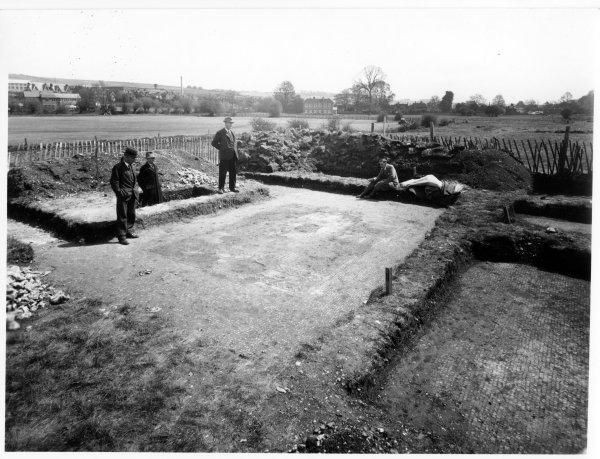 In about AD 150 the Romans came to this valley and
built a villa on the Rye. This was first discovered in 1724 when workmen
uncovered a mosaic pavement, and subsequent digs revealed a large villa with
a complex bathhouse. It stood close to the Holy Well spring whose waters
may have supplied the baths and it is thought that the villa was the centre
of a large estate with several outlying farms. Roman bricks from the villa
can still be seen in the tower of the church and in the ruins of St John’s
Hospital in Easton Street.
In about AD 150 the Romans came to this valley and
built a villa on the Rye. This was first discovered in 1724 when workmen
uncovered a mosaic pavement, and subsequent digs revealed a large villa with
a complex bathhouse. It stood close to the Holy Well spring whose waters
may have supplied the baths and it is thought that the villa was the centre
of a large estate with several outlying farms. Roman bricks from the villa
can still be seen in the tower of the church and in the ruins of St John’s
Hospital in Easton Street.
Mills and paper making
The all-important river was vital to power the mills that grew up along the
valley in the 11th century. There are twenty corn mills mentioned
in the Doomsday Book along the nine miles between West Wycombe and the Thames.
In medieval times some of the corn mills were adapted to the cloth trade.
These were called fulling mills and their function was to beat newly woven
cloth, under hammers driven by water power, to thicken and shrink it. This
trade had largely died out by 1600.
Following on from the fulling mills came the paper mills. We know that Hedge
Mill in Loudwater was operating in 1627 and the industry flourished in Wycombe
until the end of the 20th century. Paper was made from rags and
these rags were blamed for an outbreak of the plague in 1631. In 1830
some of the paper manufacturers introduced a machine called a Fourdrinier
to speed up the process. This would have meant job losses and the paper workers
were not happy about it. They grouped together and rampaged through the town
destroying as many of the machines as possible. Most of them were caught
and brought to trial, several were sentenced to death, but this was later
changed to transportation to Tasmania.
Lace and chair making
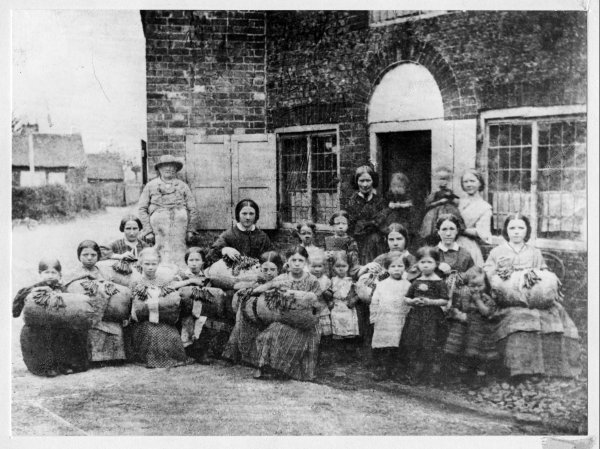 Lace making started in roughly the same time as the paper industry.
This work was undertaken by the women who supplemented the household income
by earning a pittance for long hard labour bent over lace pillows. Children
were sent to lace schools where they were taught to read while they made
lace, a practice that came to an end with the introduction of the Education
Act in 1870
Lace making started in roughly the same time as the paper industry.
This work was undertaken by the women who supplemented the household income
by earning a pittance for long hard labour bent over lace pillows. Children
were sent to lace schools where they were taught to read while they made
lace, a practice that came to an end with the introduction of the Education
Act in 1870
The chair making industry probably began in the later part of the eighteenth
century.
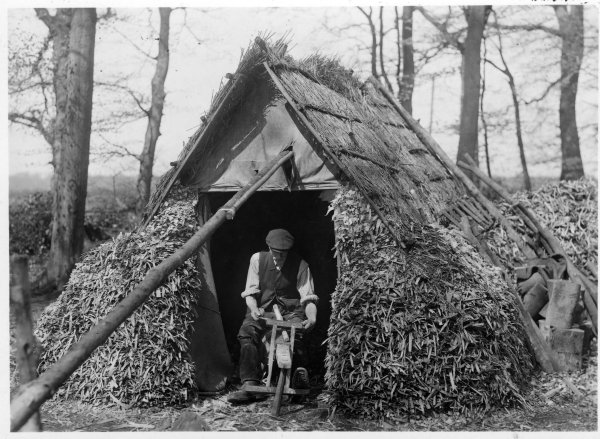 Wycombe was surrounded by Beech, Elm and Ash trees making it
ideally suited to the production of simple chairs for kitchens, servant’s
quarters and public buildings. Men known as Bodgers specialised in turning
the chair legs on a pole-lathe that was worked by a foot treadle. They worked
in the Beech woods or from a shed or hut in their back gardens. A reproduction
of a Bodgers hut can be seen at the Wycombe Museum in Priory Road. The legs
were transported by horse and cart to the furniture factories in High Wycombe
where the seats and backs were added and the chairs polished. Finally they
were packed for delivery to London, the return trip taking anything up to
thirty-six hours. A procession of loaded wagons was a familiar sight leaving
Wycombe in the early evening.
Wycombe was surrounded by Beech, Elm and Ash trees making it
ideally suited to the production of simple chairs for kitchens, servant’s
quarters and public buildings. Men known as Bodgers specialised in turning
the chair legs on a pole-lathe that was worked by a foot treadle. They worked
in the Beech woods or from a shed or hut in their back gardens. A reproduction
of a Bodgers hut can be seen at the Wycombe Museum in Priory Road. The legs
were transported by horse and cart to the furniture factories in High Wycombe
where the seats and backs were added and the chairs polished. Finally they
were packed for delivery to London, the return trip taking anything up to
thirty-six hours. A procession of loaded wagons was a familiar sight leaving
Wycombe in the early evening.
By the time the World War Two started in 1939 High Wycombe was producing
furniture of the highest quality, providing fine pieces for the wealthiest
homes in the world.
During the Second World War some of Wycombe’s furniture factories were
making aircraft components. Parts for the Tiger Moth and the De Havilland
Mosquito were all made here using the skill of the furniture workers.
Today some furniture is still made in Wycombe but our predominant industry
now is the service industry.
Education and ceremonies
In 1799 Lieutenant Colonel Gaspard Le Marchant opened a school for army
officers in the High Street. This establishment, known as the Royal Military
College, tutored the students in a wide range of skills including
trigonometry, geometry and French as well as siege warfare. They were not
happy about the accommodation in the ancient Antelope Inn, built in 1480,
but the school remained there for the next fourteen years before moving to
Farnham in Surrey.
A philanthropist called James Olliff Griffits gave the poor the opportunity
to further their education in the early 1870’s .To that end he decided
to raise funds to build the first High Wycombe public library. This was not
popular with the wealthy men of the town, as they would sooner see the working
classes in the pubs that they owned drinking their beer rather than trying
to educate themselves in a public library. In 1875 J O Griffits got his way
and, by paying for most of it himself, the old school in Church Street was
acquired and the first public library opened.
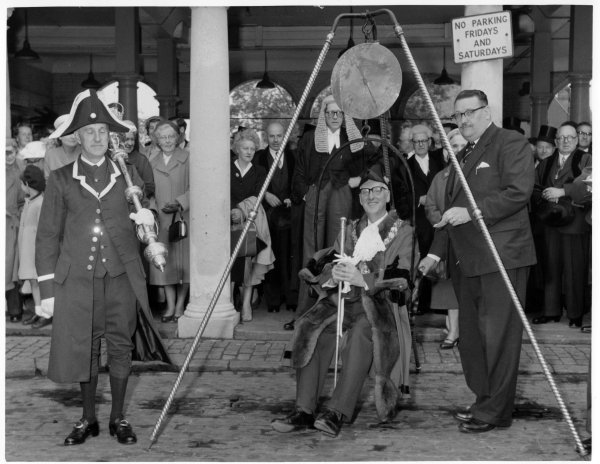 An annual event and unique to High Wycombe is the Mayor weighing
ceremony. This is believed to be an ancient custom that fell into disuse
but was revived in 1892. The outgoing Mayor and Councillors are weighed and
their weights called out to the assembled audience. If they have put on weight
it is considered to be at the taxpayers expense and the crowd jeers. If they
have lost weight the crowd cheers. The new Mayor and Councillors are also
weighed and their weights recorded. This ceremony can still be seen each
year in May.
An annual event and unique to High Wycombe is the Mayor weighing
ceremony. This is believed to be an ancient custom that fell into disuse
but was revived in 1892. The outgoing Mayor and Councillors are weighed and
their weights called out to the assembled audience. If they have put on weight
it is considered to be at the taxpayers expense and the crowd jeers. If they
have lost weight the crowd cheers. The new Mayor and Councillors are also
weighed and their weights recorded. This ceremony can still be seen each
year in May.
Newland and the Rye
The area to the west of the town centre was called Newland. This is where
some of the poorest people lived during the nineteenth and early twentieth
century. Houses were crammed together with several families sharing one toilet,
which they emptied into the Wye. A Board of Health report in 1849 had
revealed dangerously unhealthy conditions but nothing was done to improve
the situation for another thirty years. Working conditions were just as poor
in the chair making industry, employers worked adults and children for thirteen
hours a day six days a week.
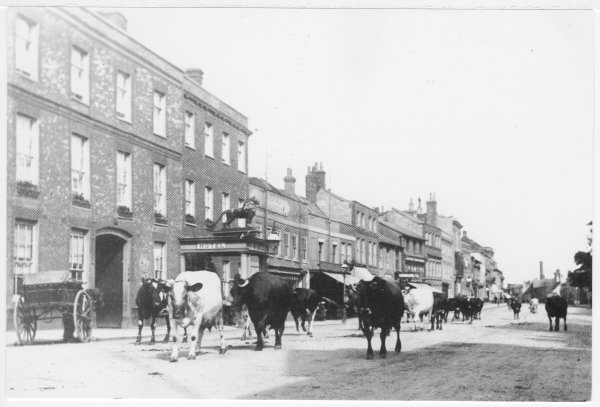 The Rye, a piece of land next to the river on the eastern side
of the town, has always been an important resource for the townsfolk. It
was reputedly the scene of a sharp skirmish during the Civil War between
Lord Wentworth’s Royalist troops and Captain Hayes who defended the
town. Some historians, however, doubt that this battle took place.
Cattle were grazed on the Rye and the daily walk to and from their owner’s
homes was a familiar site until 1927 when an act of Parliament was passed
stipulating that the Rye could only be used for recreational purposes.
The Rye, a piece of land next to the river on the eastern side
of the town, has always been an important resource for the townsfolk. It
was reputedly the scene of a sharp skirmish during the Civil War between
Lord Wentworth’s Royalist troops and Captain Hayes who defended the
town. Some historians, however, doubt that this battle took place.
Cattle were grazed on the Rye and the daily walk to and from their owner’s
homes was a familiar site until 1927 when an act of Parliament was passed
stipulating that the Rye could only be used for recreational purposes.
The future
During the development of the town in the 1960's, the River Wye was banished
under the shopping centre. It was hoped that the 2006 development known as
Eden would once again restore the Wye to be an important feature of our town.
However, it was not to be, but the new development has provided spacious
new shopping and leisure facilities together with a state of the art
public library. Future development is planned to the Abbey Way area which
will provide a golden opportunity to open up Wycombe's historic river once
more.
 In about AD 150 the Romans came to this valley and
built a villa on the Rye. This was first discovered in 1724 when workmen
uncovered a mosaic pavement, and subsequent digs revealed a large villa with
a complex bathhouse. It stood close to the Holy Well spring whose waters
may have supplied the baths and it is thought that the villa was the centre
of a large estate with several outlying farms. Roman bricks from the villa
can still be seen in the tower of the church and in the ruins of St John’s
Hospital in Easton Street.
In about AD 150 the Romans came to this valley and
built a villa on the Rye. This was first discovered in 1724 when workmen
uncovered a mosaic pavement, and subsequent digs revealed a large villa with
a complex bathhouse. It stood close to the Holy Well spring whose waters
may have supplied the baths and it is thought that the villa was the centre
of a large estate with several outlying farms. Roman bricks from the villa
can still be seen in the tower of the church and in the ruins of St John’s
Hospital in Easton Street.
 Lace making started in roughly the same time as the paper industry.
This work was undertaken by the women who supplemented the household income
by earning a pittance for long hard labour bent over lace pillows. Children
were sent to lace schools where they were taught to read while they made
lace, a practice that came to an end with the introduction of the Education
Act in 1870
Lace making started in roughly the same time as the paper industry.
This work was undertaken by the women who supplemented the household income
by earning a pittance for long hard labour bent over lace pillows. Children
were sent to lace schools where they were taught to read while they made
lace, a practice that came to an end with the introduction of the Education
Act in 1870
 Wycombe was surrounded by Beech, Elm and Ash trees making it
ideally suited to the production of simple chairs for kitchens, servant’s
quarters and public buildings. Men known as Bodgers specialised in turning
the chair legs on a pole-lathe that was worked by a foot treadle. They worked
in the Beech woods or from a shed or hut in their back gardens. A reproduction
of a Bodgers hut can be seen at the Wycombe Museum in Priory Road. The legs
were transported by horse and cart to the furniture factories in High Wycombe
where the seats and backs were added and the chairs polished. Finally they
were packed for delivery to London, the return trip taking anything up to
thirty-six hours. A procession of loaded wagons was a familiar sight leaving
Wycombe in the early evening.
Wycombe was surrounded by Beech, Elm and Ash trees making it
ideally suited to the production of simple chairs for kitchens, servant’s
quarters and public buildings. Men known as Bodgers specialised in turning
the chair legs on a pole-lathe that was worked by a foot treadle. They worked
in the Beech woods or from a shed or hut in their back gardens. A reproduction
of a Bodgers hut can be seen at the Wycombe Museum in Priory Road. The legs
were transported by horse and cart to the furniture factories in High Wycombe
where the seats and backs were added and the chairs polished. Finally they
were packed for delivery to London, the return trip taking anything up to
thirty-six hours. A procession of loaded wagons was a familiar sight leaving
Wycombe in the early evening.
 An annual event and unique to High Wycombe is the Mayor weighing
ceremony. This is believed to be an ancient custom that fell into disuse
but was revived in 1892. The outgoing Mayor and Councillors are weighed and
their weights called out to the assembled audience. If they have put on weight
it is considered to be at the taxpayers expense and the crowd jeers. If they
have lost weight the crowd cheers. The new Mayor and Councillors are also
weighed and their weights recorded. This ceremony can still be seen each
year in May.
An annual event and unique to High Wycombe is the Mayor weighing
ceremony. This is believed to be an ancient custom that fell into disuse
but was revived in 1892. The outgoing Mayor and Councillors are weighed and
their weights called out to the assembled audience. If they have put on weight
it is considered to be at the taxpayers expense and the crowd jeers. If they
have lost weight the crowd cheers. The new Mayor and Councillors are also
weighed and their weights recorded. This ceremony can still be seen each
year in May.
 The Rye, a piece of land next to the river on the eastern side
of the town, has always been an important resource for the townsfolk. It
was reputedly the scene of a sharp skirmish during the Civil War between
Lord Wentworth’s Royalist troops and Captain Hayes who defended the
town. Some historians, however, doubt that this battle took place.
Cattle were grazed on the Rye and the daily walk to and from their owner’s
homes was a familiar site until 1927 when an act of Parliament was passed
stipulating that the Rye could only be used for recreational purposes.
The Rye, a piece of land next to the river on the eastern side
of the town, has always been an important resource for the townsfolk. It
was reputedly the scene of a sharp skirmish during the Civil War between
Lord Wentworth’s Royalist troops and Captain Hayes who defended the
town. Some historians, however, doubt that this battle took place.
Cattle were grazed on the Rye and the daily walk to and from their owner’s
homes was a familiar site until 1927 when an act of Parliament was passed
stipulating that the Rye could only be used for recreational purposes.